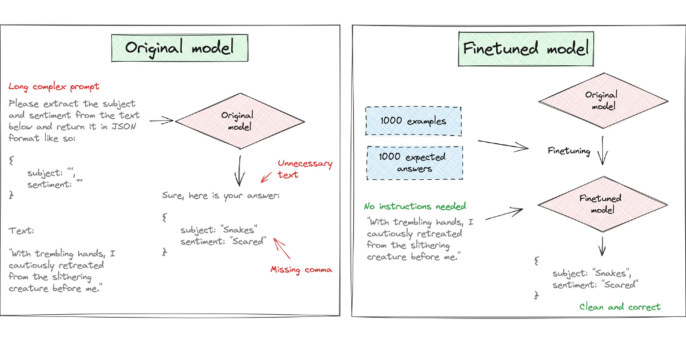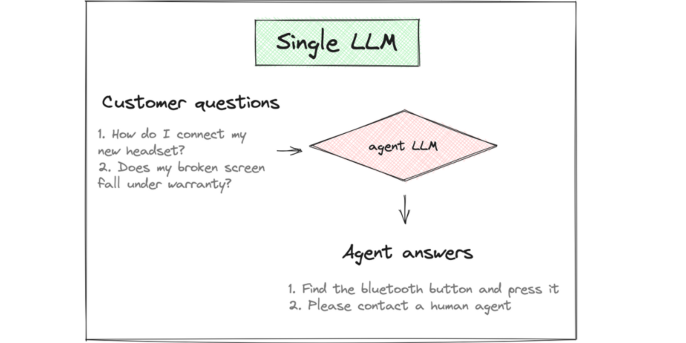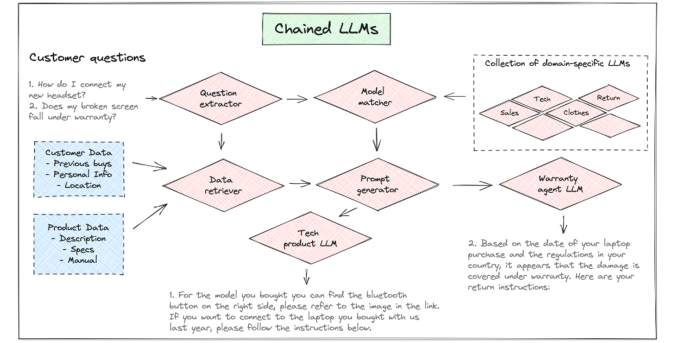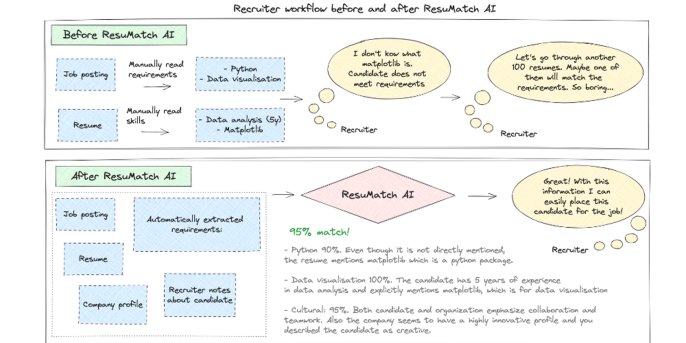20. July 2023 By René Wilbers and Simon Houtman
Creating Business Value with Large Language Models like ChatGPT!
In the rapidly evolving world of artificial intelligence (AI), large language models (LLMs) have emerged as powerful tools with the potential to revolutionize various aspects of our lives. Trained on vast amounts of text data, LLMs, such as ChatGPT, can interpret natural language and generate human-like responses, making them invaluable assets for businesses seeking to enhance customer experiences, automate tasks, and drive innovation. This blog highlights how to get most business value out of LLMs by fine-tuning them to meet your specific requirements, integrating multiple LLMs in a unified application, and utilizing open-source LLMs to tackle privacy and security concerns while avoiding vendor lock-in and enhancing the overall level of customization. Finally, we present a vision of how AI will revolutionize the future of office work with the introduction of ResuMatch AI – an innovative product developed by adesso Data & Analytics featuring an advanced AI assistant for recruiters that leverages the capabilities of ChatGPT.

Figure 1: Finetuned LLMs are tailored to your business process.
Finetuned LLMs are Tailored to Your Business Process
The true power of LLMs lies in their adaptability. The finetuning process allows these models to adapt to specific business needs, enhancing their efficacy in various applications such as creating customized marketing content or predicting stock market trends. The rapidly evolving landscape of fine-tuning techniques is just as exciting as the development of new LLMs themselves. This progression allows businesses to tailor LLMs with increasing precision, which ultimately translates to increased business value.
Commercial LLMs like ChatGPT and Claude can be easily finetuned using their API with a specific dataset. For instance, a collection of your company's past emails can be used to create an efficient automated email drafting system. The number of examples needed for finetuning can vary, but typically a few thousand examples should be sufficient, depending on the complexity of the task and the specificity of the language involved.
When finetuning an open source LLM, you have the freedom to pick the method yourself. However, we recommend picking a technique that falls under Parameter Efficient FineTuning (PEFT). With the use of these techniques, you only need to retrain a small fraction of the parameters, which gives a massive boost to your training speed and performance while keeping computational costs and hardware requirements low.
Some promising examples of the latest PEFT techniques are Quantized Low Rank Adapters (QLoRA), Low Rank Adapters (LoRA), Prefix Tuning, P-Tuning, Prompt Tuning and AdaLoRA. All of these can be implemented using the PEFT library from Hugging Face (for more info: https://huggingface.co/blog/peft).
Master Task Division: Unlocking Efficiency with Chained LLMs
Harnessing the collective power of multiple LLMs can lead to significant improvements. By chaining LLMs together, we can break down complex tasks and distribute them among different models, each fine-tuned for a specific task. This process effectively divides complex tasks into manageable segments that can be addressed by different models. For instance, an LLM specializing in extracting key details from natural language could extract customer feedback while another model, fine-tuned for sentiment analysis, gauges the customer sentiment. This coordinated approach can greatly enhance the depth and precision of insights drawn from the data.
A useful framework for chaining LLMs and integrating them into applications is LangChain (https://docs.langchain.com/docs/). This open-source project launched in October 2022, and has quickly gained popularity for its versatility and ease of use. LangChain supports integrations with a wide range of systems, including major cloud platforms (Amazon, Google, Microsoft Azure), API wrappers for various information sources (news, movies, weather), code and document analysis tools, web scraping subsystems, and most importantly, several language models including OpenAI, Anthropic, and many models from Hugging Face. These features provide developers with a powerful toolkit to chain multiple LLMs together for complex tasks.


Figure 2: Master task division: unlocking efficiency with chained LLMs
Open Source LLMs Beat ChatGPT When It Comes to Business Value
While ChatGPT grabs the spotlight in the AI realm, open-source LLMs are steadily gaining momentum. With new models surfacing every week and a growing body of collaborative training data, they are quickly closing the performance gap with ChatGPT. These open-source alternatives are set to revolutionize the landscape, offering a variety of advantages that make them an enticing alternative for businesses. Let's explore some of the key benefits:
- 1. Privacy and Security: When it comes to handling sensitive data, businesses must adhere to strict data privacy regulations. Open-source LLMs can be hosted in-house, giving businesses complete control over their data, and minimizing the risk of data breaches.
- 2. Affordability: Open-source LLMs are generally free to use and modify. While there might be costs associated with infrastructure, training, and maintaining these models, they are often more cost-effective than their commercial counterparts, which often involve substantial subscription or usage fees.
- 3. Customization: One of the biggest opportunities of using open-source LLMs is their flexibility. Businesses can modify and fine-tune these models to perfectly suit their needs. This level of customization is often not available with commercial models, which are typically provided as-is and can only be fine-tuned within defined parameters.
- 4. Avoiding Lock-In: Relying on commercial LLMs can lead to vendor lock-in, where a business becomes dependent on a vendor for products and services, unable to use another vendor without substantial switching costs. With open-source LLMs, businesses have the freedom to switch providers or adjust their strategies without being constrained by a specific vendor.
Platforms like Hugging Face (https://huggingface.co/) provide a rich library of pre-trained open-source models that can be chosen based on specific needs. Once a suitable model is selected, it can be further customized and integrated into your existing systems, enhancing various business processes, and providing significant value.
ResuMatch AI Leverages ChatGPT for Job Matching
ResuMatch AI, an LLM-powered application developed by our Data & Analytics team at adesso, is a great demonstration of how LLMs can create substantial business value. Leveraging the language capabilities of ChatGPT, ResuMatch AI revolutionizes the recruitment process by insightfully matching people to job postings.
Insightful is really the keyword here, as the application deeply comprehends job descriptions, CVs, and recruiter notes. It can ‘read between the lines’ and understand qualifications, experiences, and soft skills required for specific roles. A unique aspect of ResuMatch AI is that it can estimate how likely someone can meet a requirement even if it’s not explicitly stated on the resume. In addition to showing a compatibility score, the algorithm will even give an explanation why! This takes a huge burden from recruiters as domain-specific knowledge is not required anymore, and they don’t have to tediously go through a large pile of documents, leaving only the fun part: the human interaction.
How did we do this? That’s right, as described above we built an application which chained multiple LLMs and models together, each part optimized for the subtask it performs. Moreover, once ResuMatch AI is implemented in the recruiting workflow, it continuously learns and adapts to improve its matching accuracy over time. As more data is fed into the system, the algorithm becomes increasingly proficient at identifying ideal candidates for a job posting (or the other way around).

Figure 3: Recruiter workflow before and after ResuMatch AI
Conclusion
LLMs like ChatGPT have the potential to significantly reshape businesses, fostering efficiency, innovation, and a superior customer experience. While the path to full integration may seem challenging, the rewards are well worth the effort. As we continue to explore the potential of AI and LLMs, one thing is certain - the future of business is increasingly becoming intertwined with the progression of AI technology. It's an exciting time, and we are just beginning to scratch the surface of the immense potential that LLMs hold for business transformation.
However, it is essential for businesses to understand that LLMs are not one-size-fits-all solutions. Each business has unique needs and circumstances, and successful application of LLMs requires careful consideration and planning. From selecting the right model and fine-tuning it to meet specific business needs, to integrating it into existing processes, every step is critical to reaping the full benefits of these advanced tools. We hope that the innovative tools we introduced here may help you overcome these difficulties and gain a competitive edge.
The ResuMatch AI application developed by the adesso Data & Analytics team showcases the transformative potential of LLMs for reshaping the future of office work, enabling a greater efficiency and better-informed decision-making. Embracing LLMs is not just a trend but a strategic move that can unlock tremendous value and propel businesses forward in the era of artificial intelligence.
Do you need help in picking the right LLM, finetuning it for your domain or specifc task, deploying it in the cloud and creating a chained application with multiple LLMs? Contact us!


